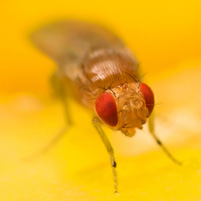Fruit Fly Efficiency

The way a fruit fly arranges its tiny, hair-like feelers is so efficient, scientists in Israel and at Carnegie Mellon University are taking serious note of it.
The team says a similar scheme could be used to more effectively deploy wireless sensor networks and other applications.
What's so unusual about it?
According to CMU's Ziv Bar-Joseph, the cells in the fly's developing nervous system manage to organize themselves so that a small number serve as leaders.
These leaders provide direct connections with every other nerve cell. And they do this with minimum communication and no advance knowledge of how they are connected with each other.
It's the same sort of scheme used to manage the distributed computer networks that, say, search the web or control an airplane in flight.
But the fly's method is much simpler and more robust than anything humans have concocted.
Bar-Joseph is an associate professor of machine learning and computational biology at CMU.
"It is such a simple and intuitive solution, I can't believe we did not think of this 25 years ago," said co-author Noga Alon.
Alon is a mathematician and computer scientist at Tel Aviv University and the Institute for Advanced Study in Princeton.
The researchers found the fruit fly's solution has qualities that make it particularly well-suited for networks in which the number and position of the nodes is not completely certain.
These include wireless sensor networks, such as environmental monitoring where sensors are dispersed in a lake or waterway. Or systems for controlling swarms of robots.
"Computational and mathematical models have long been used by scientists to analyze biological systems," said Bar-Joseph.
He continued, "Here we've reversed the strategy, studying a biological system to solve a long-standing computer science problem."
Bar-Joseph is a member of the Lane Center for Computational Biology in CMU's School of Computer Science.
Bar-Joseph and Alon are joined by co-authors Yehuda Afek of Tel Aviv University and Naama Barkai, Eran Hornstein and Omer Barad of the Weizmann Institute of Science in Rehovot, Israel.
The study appears in the Jan. 14 edition of the journal Science. This research was supported in part by grants from the National Institutes of Health and the National Science Foundation.
Related Links: Read More | Machine Learning | Ray & Stephanie Lane Center for Computational Biology | School of Computer Science
